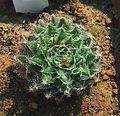| Haworthia arachnoidea | |
|---|---|
 | |
| Haworthia arachnoidea | |
| Scientific classification | |
| Kingdom: | Plantae |
| Clade: | Tracheophytes |
| Clade: | Angiosperms |
| Clade: | Monocots |
| Order: | Asparagales |
| Family: | Asphodelaceae |
| Subfamily: | Asphodeloideae |
| Genus: | Haworthia |
| Species: | H. arachnoidea |
| Binomial name | |
| Haworthia arachnoidea Haw. | |
Haworthia arachnoidea, locally known as "papierrosie" (paper-rose) or "spinnekopnes" (spider-nest), is the type species of the genus Haworthia , in the family Asphodelaceae, in the Western Cape Province of South Africa. [1]


